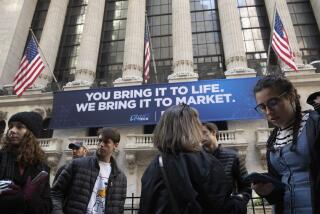Stock market’s weekly winning streak comes to an end
NEW YORK — The stock market’s longest weekly winning streak in a year came to an end as summer doldrums set in on Wall Street.
Major U.S. indexes closed moderately lower Friday, with the Dow Jones industrial average sagging 72.81 points, or nearly 0.5%, to 15,425.51. For the week, the Dow and other indexes finished down about 1%, ending a string of six straight weekly gains.
Some analysts saw the pullback as a temporary lull amid minimal economic data. Trading volume was especially light as money managers started their annual August getaways.
“The market’s just taking a breather,” said Jay Wong, a portfolio manager at Payden & Rygel in Los Angeles. “Is this the beginning of the end? I don’t think so.”
The broader Standard & Poor’s 500 index fell 6.06 points, or nearly 0.4%, to 1,691.42. The technology-focused Nasdaq composite index dropped 9.01 points, or 0.25% to 3,660.11.
Even as Wall Street headed to the beach, investors began to train their gaze on the market’s next expected obstacles: a looming fiscal battle in Washington and the Federal Reserve’s potential tapering of its monthly bond buying, part of its overall stimulus strategy to spur the economic recovery.
President Obama and Congress are set to resume a tug of war over the federal government’s borrowing limits and spending cuts this fall. As early as September, the Fed could begin scaling back a bond-buying program that has helped push stocks up almost 20% this year.
“It’s that uncertainty that’s going to cause the market to get a little concerned,” said Randy Frederick, managing director of active trading and derivatives at Charles Schwab.
Last week’s handful of economic reports were generally upbeat.
The average weekly jobless claims over four weeks dropped to the lowest level since 2007. And there was encouraging data out of China, where signs of a slowdown had been worrying investors. Chinese exports rose 5.1% in July, while imports surged 10.9% compared with the same period a year earlier.
On Friday, however, the U.S. Commerce Department reported that wholesale inventories fell 0.2% in June, disappointing analysts who expected a 0.4% rise.
The recent stream of money that had been flowing into stocks began slowing in late July, according to Investment Company Institute data. Investors shoveled $714 million into stock funds in the week that ended July 31, significantly less than the $4.2 billion the previous week.
The next major read on the U.S. economy’s health will come in early September, when the Labor Department reports how many jobs the economy added in August. That report will then fuel speculation about whether the Fed, at its mid-September meeting, will begin tapering its $85 billion in monthly bond purchases.
The bond-buying has been aimed at keeping a lid on long-term interest rates to make borrowing cheaper so consumers and companies can easily purchase new goods and raise capital.
Low rates have made bonds less attractive, and that has pushed investors into riskier assets such as stocks, fueling this year’s rally. Despite this week’s pullback, the Dow is still up nearly 18% this year.
Slowing down the Fed’s stimulus could rattle nerves on Wall Street and potentially lead to a sharp sell-off in stocks.
“That’s going to be a little disturbing to people, but frankly the year overall is still going to look pretty good,” Frederick said.






